Romancing the stone: How one man has taken the craft of dry-stone walling and turned it into an art
Tom Trouton's works at The Newt and elsewhere set him apart as a master of one of our oldest heritage crafts.
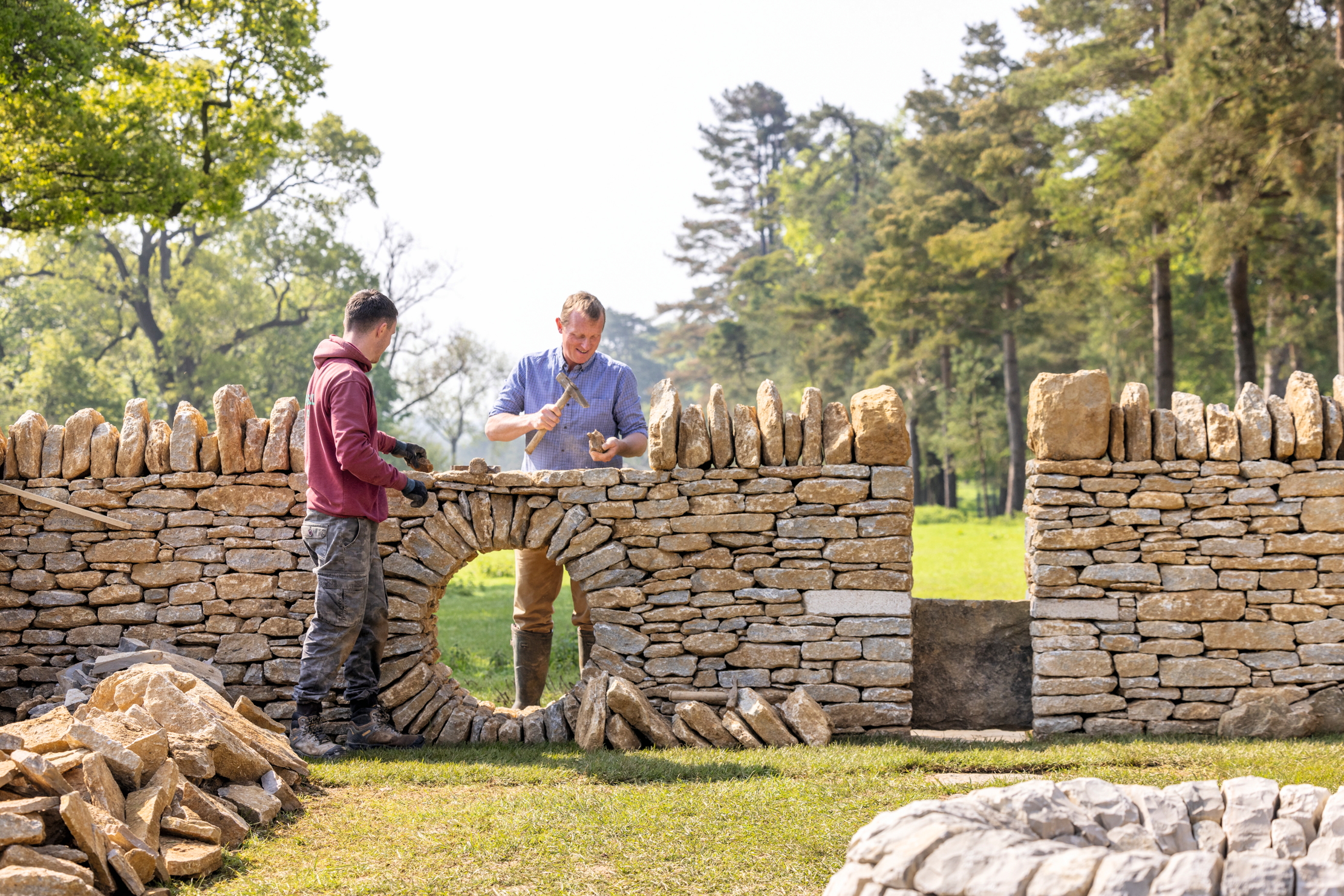
From a distance, the nearly completed walled enclosure, where two figures are companionably chipping away at one of the walls, could be mistaken for a sheepfold. In fact, this is a workshop space in the middle of a field at the Somerset estate of The Newt, where dry-stone wallers Tom Trouton and his stepson, Liam Brady, are ‘planting’ a stone tree into the waist-high wall. There is no technical plan, no metal framework — only three piles of stones, a bucket of hammers and Mr Trouton’s skill.
The leaning trunk in beige Hadspen limestone, which looks brown set against the grey tones of the wall, is already in place and now Mr Trouton selects a chunky piece of Shaftesbury greenstone, rounds off the edges with a few sharp knocks of the hammer and fits it onto the wall, where it becomes the first leaf. ‘I’ve been used to seeing windswept trees on Exmoor, where I grew up, and I think this gives the tree more depth,’ he explains.
As the tree grows, stone upon stone, the waller reveals this is his second time creating one. The first was for the owners of a contemporary house in Dorset, who wanted a curved dry-stone wall with a recess for a bench and some trees. On his first site visit, Mr Trouton asked where the trees were to be planted and they replied that they wanted two trees in the wall itself, to create interest all year round.
‘Momentarily, I thought, “Well that’s not going to work very well” — and then it clicked. “Aah, you want stone trees…”’ Undaunted, he immediately decided the trees should look authentic and started planning their design in his head. ‘I think I’m very lucky — I’ve always been able to visualise things,’ he reflects.
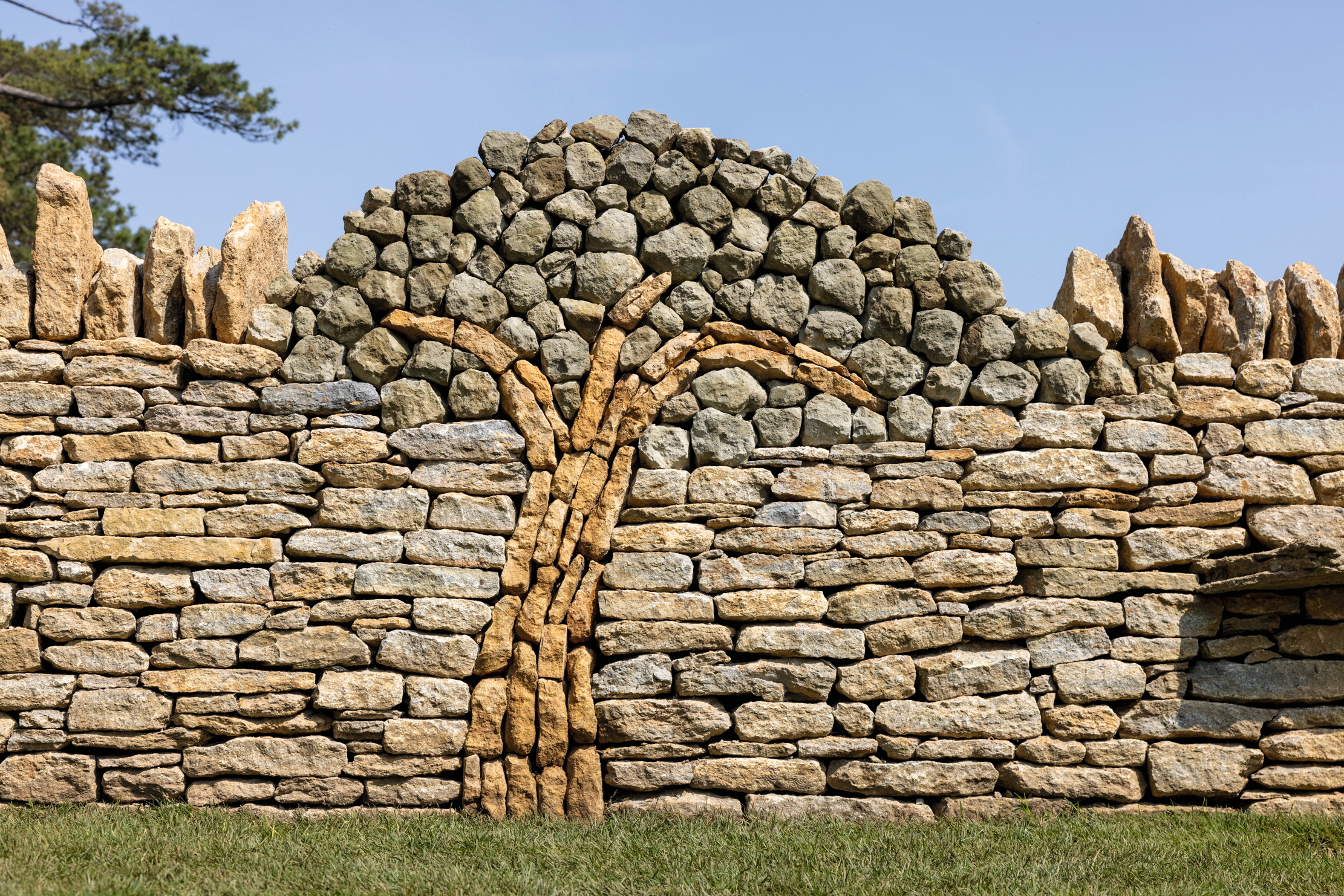
The tree in the wall at The Newt is there to show those who attend Mr Trouton’s workshops the range of applications that dry-stone work offers. When he and his team (he employs six wallers, including his son, Joseph, all of whom he has trained) finish the enclosure, it will showcase retaining walls, a firepit, a wildlife pond, stiles, an ornamental pear, a moongate and a hedgehog-sized lunky (a hole at the base of the wall, traditionally made for sheep or lambs to pass through).
Mr Trouton’s relationship with stones and walls started on his parents’ farm on Exmoor, where he spent many hours watching a traditional waller at work, making and repairing stone banks, a style of wall seen across the South-West. Aged 10, he made his first dry-stone wall from shillet (a form of slate), when, keen to make a den on the far side of a steep slope, he cut a pathway through the turf with a pickaxe and shored it up on one side with the stone he’d excavated. ‘I remember it being about 8ft high and 300ft long, but, in reality, it was about 10in high and 6ft long.’ Clearly, he already had a talent for choosing and placing stones, as, when his parents sold the property 15 years later, the wall was still standing.
In his twenties, Mr Trouton moved to south Somerset, got married and worked in a small quarry, where he was introduced to forest marble, a Jurassic limestone that has subtle tones of grey, yellow, gold and blue, as well as occasional fragments of unfossilised wood and other plant life (which explain the ‘forest’ part of its name). ‘I learned a huge amount about the stone from the quarry owner. He taught me how to read it, its composition and its grain, which helped me understand where to split it,’ he recalls.
Sign up for the Country Life Newsletter
Exquisite houses, the beauty of Nature, and how to get the most from your life, straight to your inbox.
Now, after more than 20 years of walling, this is Mr Trouton’s preferred stone, for its durability, variation in hues and the rustic effect it creates, although he admits that it can be tricky to dress. In Yorkshire, where he moved with his young family to work with his brother on a stud farm, he grew to appreciate the beauty of the more clearly defined courses in the dry-stone walls there, made possible by using Yorkstone and millstone grit, which are easier to split than forest marble. It was these stones he worked with when he set up as a full-time waller, in 2004.
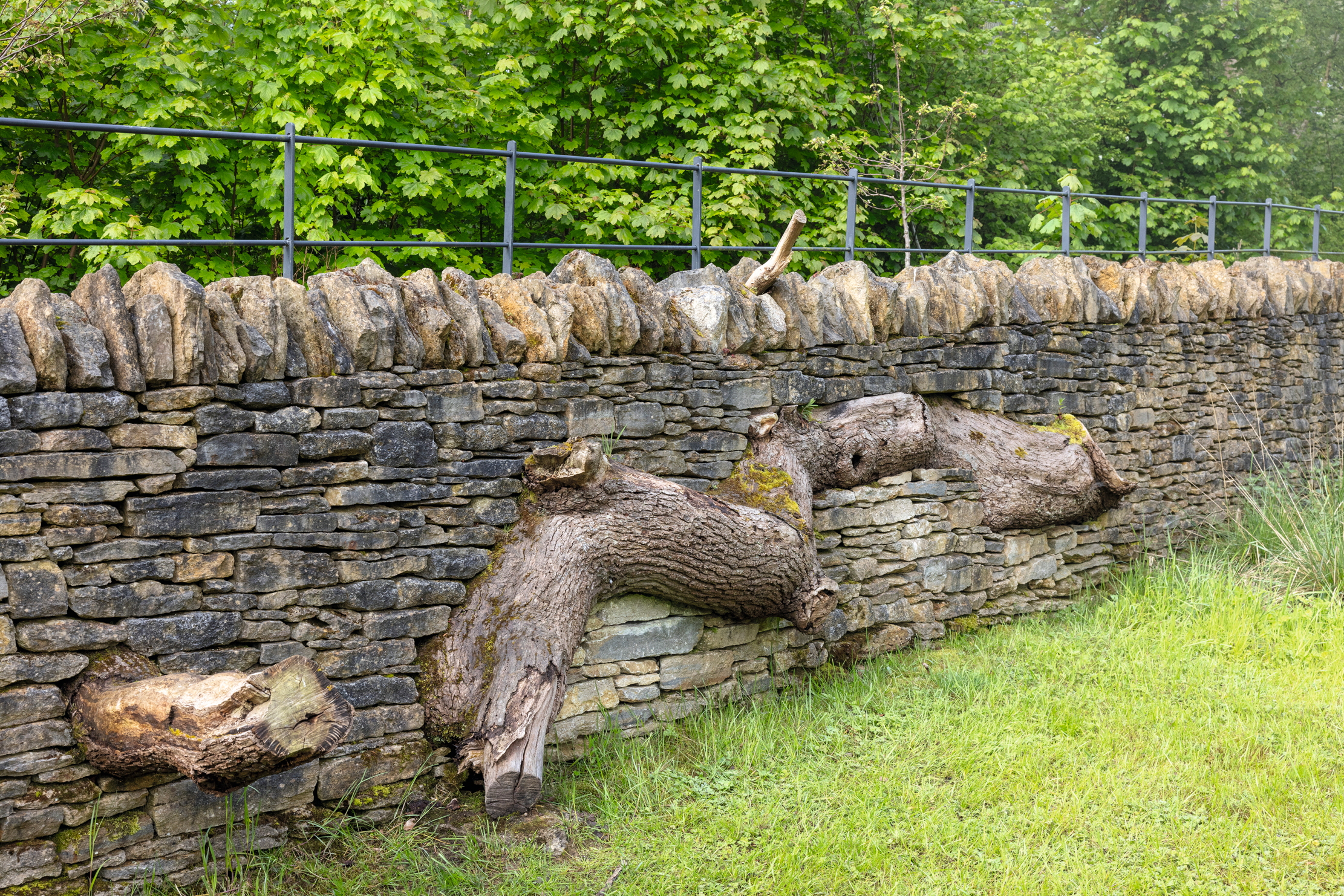
When he returned to the South-West, Mr Trouton discovered an increasing demand for dry-stone walls, both new ones and repairs. Depending on how much dressing the stone needs, he reckons on completing about 5ft of a double-skinned wall, at 3ft high, in a day. To speed up his workflow, the waller took on his first apprentice, then two more, when, a year later, he landed a demanding project in Jersey. Taking 18 months to complete, the job involved retaining walls, freestanding walls, steps for an amphitheatre and cladding for a massive extension to a historic house.
In 2015, he was asked by the estate manager at The Newt to build a retaining wall for a ha-ha. Mr Trouton submitted a quote and was then invited to give a rate per metre as, he was told, ‘there may be one or two more walls to build’. Nine years later, with many miles of walls and a variety of dry-stone features completed, his yellow van, emblazoned with the logo ‘Crafted Today for Tomorrow’s Generation’, is still a familiar sight on the estate.
Much of Mr Trouton’s work in the historic walled garden and within the wider estate has already settled into the landscape, which is exactly the weathered look the owner, Koos Bekker, had wanted. The craftsman relates how Mr Bekker warned him: ‘I don’t want any of the walls you’re building to look ornate or perfect. I want them to be agricultural, to have nooks and crannies, humps, bumps and dips.’
For Mr Trouton, this was a particular challenge, as the professionally built dry-stone wall is one where the stones fit tightly together, the profile is straight and the coping stones sit snugly against each other, leaving no space for debris or weather to damage the top. Although he has allowed these walls to be a bit more relaxed than perhaps he would like, he’s permitted no compromises with the soundness of their construction.
‘The two things you can’t see are, I think, the most important things about wall building: the foundations and the infill,’ Mr Trouton explains. ‘You don’t need a deep foundation — up to 8in is enough — but you need to build on a solid surface, such as compacted soil. If you’re using a stone infill, as we do, the pieces need to be fitted, not simply thrown in, otherwise it will settle later and the wall will start to bow.’ He would expect a dry-stone wall to last for 100–150 years with minimal maintenance, which includes checking for the odd loose stone and pulling off any plants with strong roots, such as ivy or brambles.
The principles of successful walling are the same as for other dry-stone work on the land or in gardens. Having made waterfalls, wildlife ponds, seats, huts and, at one site, a ruined house to contain a water pump (not his favourite work, as ruins, he says, can look like unfinished walls to him, if not built skilfully), Mr Trouton decided to make a stone apple as a gift for Mr Bekker. He modelled it on a Somerset variety, Hoary Morning, which he grew in his own garden, and created three templates in plywood.
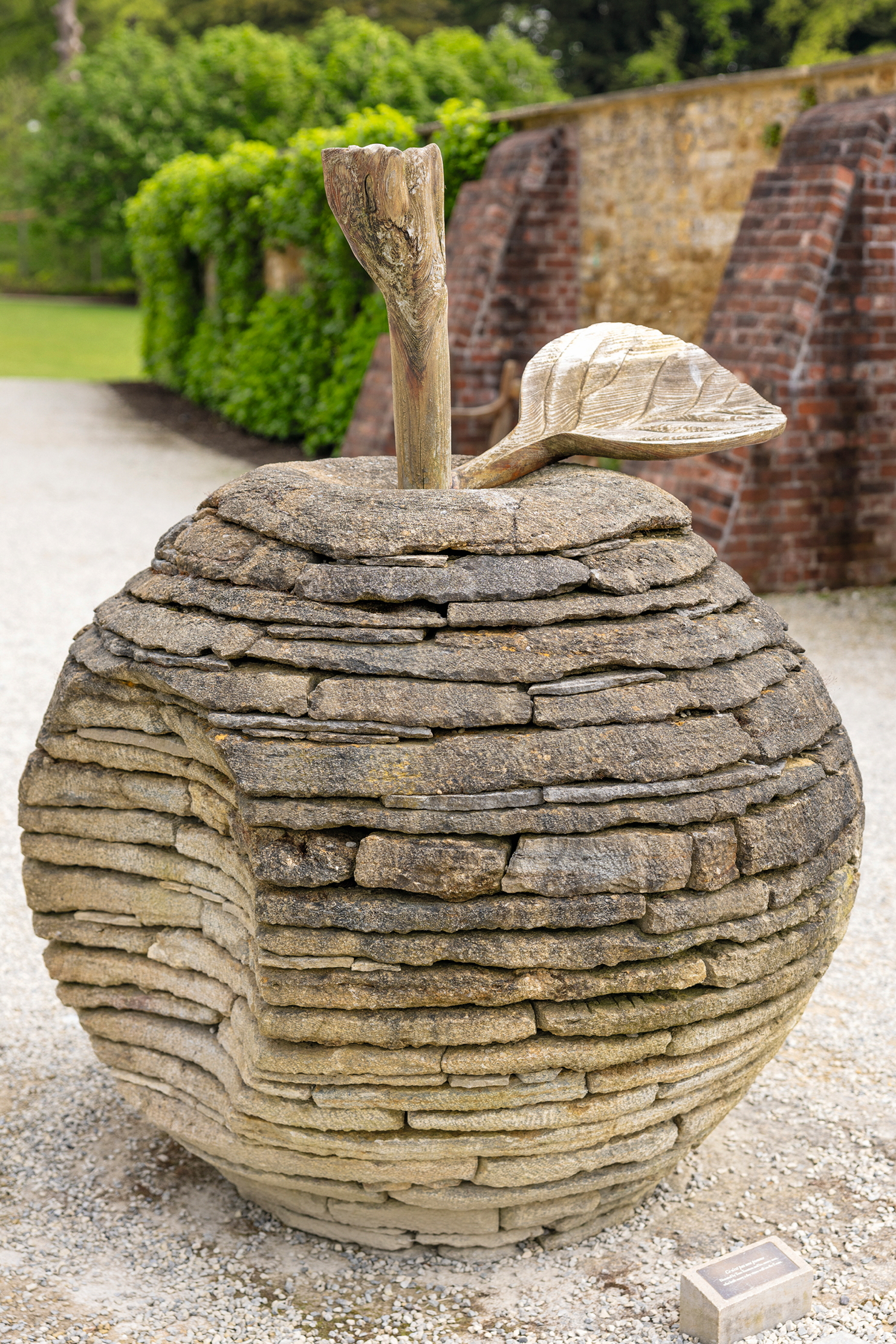
To add to the challenge, his nephew, who sometimes works with him, suggested the apple should have a bite taken out of it, for realism. The resulting three-ton sculpture, which has a stalk and leaf carved from cedar from the estate, sits on a huge slab of forest marble at the entrance to the Parabola Garden at The Newt, a monumental tribute to Mr Trouton’s artistry. Commissions for dry-stone fruits have flowed ever since.
He still loves to step out of his comfort zone and, when he was asked to embellish a new wall at The Newt with rocks that ‘some people might see as sheep’, he jumped at the chance. His placing of two lumps of ironshot stone, selected at a local quarry, each with an oval-shaped black ‘head’ angled inquisitively at neck level, really does suggest a pair of sheep that might at any moment step out of the wall and start cropping the wildflowers in front. It is no surprise that this is Mr Trouton’s favourite piece of stone work so far.
RHS Chelsea Flower Show 2024: See all the gold medallists
We take a look at all the gold medallists from the 2024 RHS Chelsea Flower Show. All photographs by Andrew

'Nothing wrong with a bit of furore': An insider's guide to judging the Chelsea Flower Show, by RHS senior judge James Alexander-Sinclair
James Alexander-Sinclair comes to the Country Life podcast to talk about his career in gardening, and his two decades spent
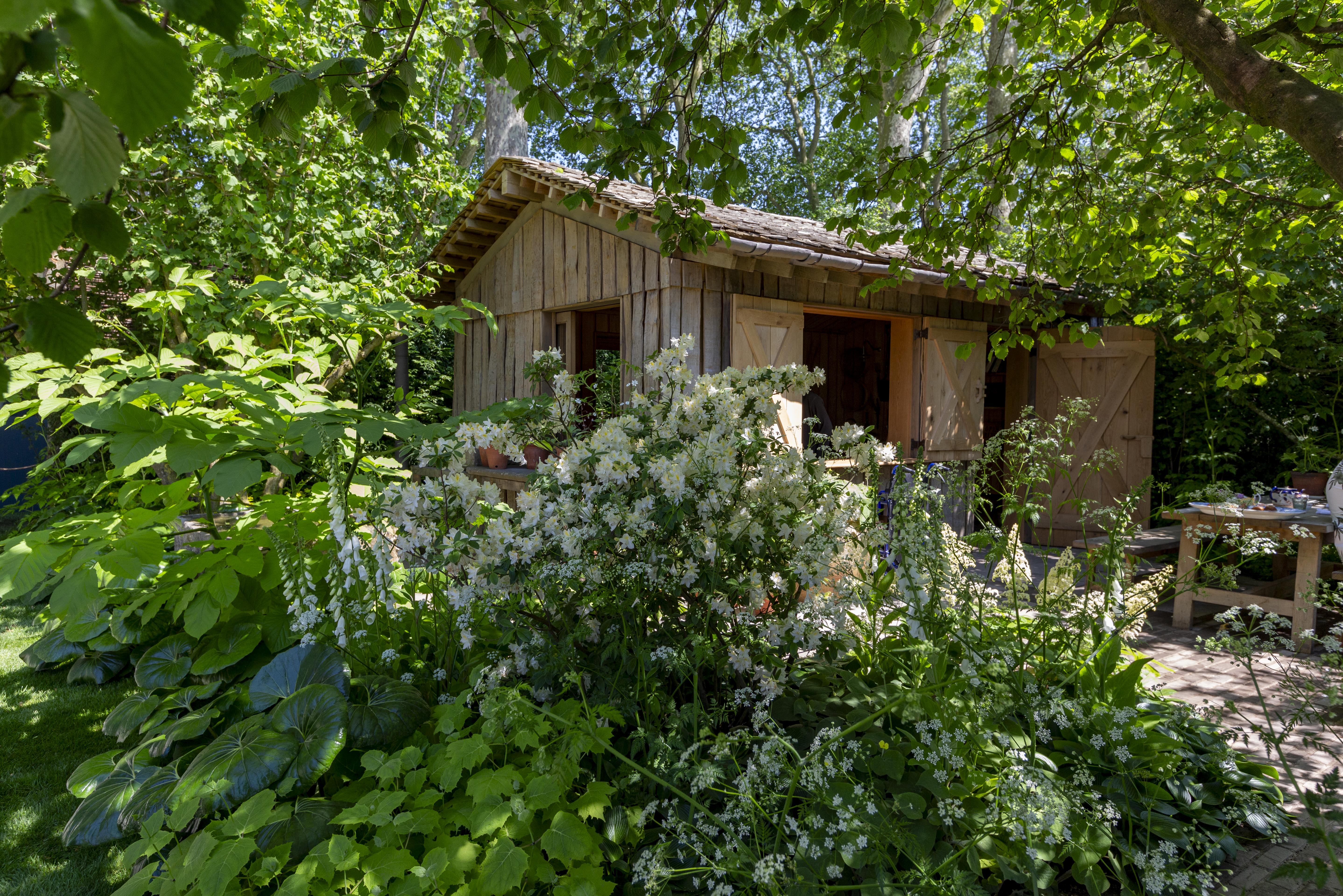
Alan Titchmarsh on Chelsea 2024: 'We need controversy to make us think... Just don’t expect me to regard slugs and snails as my friend'
Alan Titchmarsh looks ahead to the 'matchless spectacle' of the 2024 Chelsea Flower Show, the 'Paris catwalk of the British

'A haunt of ancient peace' — The gardens at Iford Manor and their remarkable history
In a home that can trace its history to the Norman Conquest, owners William and Marianne Cartwright-Hignett have continued the

